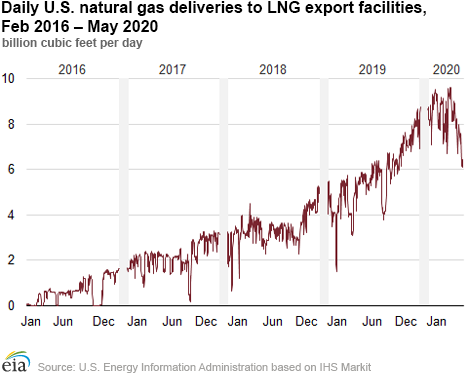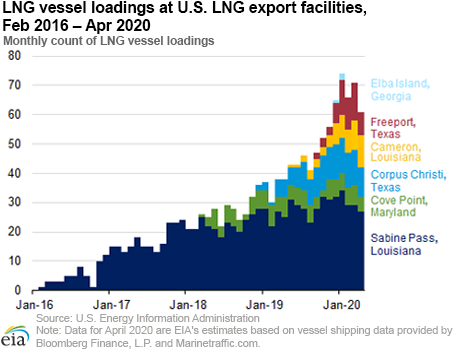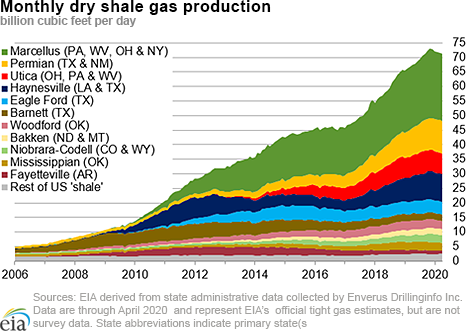In the News:
Natural gas deliveries to U.S. LNG export facilities decline to the lowest level since October 2019
Natural gas deliveries to U.S. facilities producing liquefied natural gas (LNG) for export ("LNG feedgas") declined to 5.6 billion cubic feet per day (Bcf/d) on May 24, 2020, and averaged 6.7 Bcf/d from May 1 through May 26, according to data by IHS Markit. This was the lowest level of LNG feedgas deliveries since October 2019, despite 2.0 Bcf/d baseload (2.3 Bcf/d peak) of new liquefaction capacity that was commissioned over this period.
Declining levels of feedgas to LNG export facilities (and LNG export volumes) reflect a seasonal decline in LNG demand in the major consuming markets in Asia and Europe, as well as the reduction in global LNG demand resulting from mitigation efforts related to the corona virus (COVID-19), and historically low global LNG spot prices, which reduce economic viability of U.S. LNG exports. Lower levels of U.S. LNG exports are expected to continue through the summer as buyers have cancelled as many as 20 cargoes for June delivery and up to 45 cargoes for July delivery, according to trade press reports.
U.S. LNG feedgas and exports set new records this winter (December 2019–February 2020), averaging 8.3 Bcf/d and 7.6 Bcf/d, respectively, over this period, supported by the strong LNG demand in Europe and Asia. U.S. LNG feedgas continued to remain at high levels in March and April, averaging 8.6 Bcf/d and 8.2 Bcf/d, respectively, before declining below 6 Bcf/d from May 20 through May 24.
In January 2020, 74 LNG export cargoes were loaded in the United States—the highest monthly volume to date—followed by 66 cargoes in February, 71 cargoes in March, and an estimated 61 cargoes in April. EIA also estimates that 40 cargoes were loaded between May 1 through May 24, which amounted to an estimated 5.8 Bcf/d of LNG exports, compared to 7.0 Bcf/d exported over the same period in April. The Sabine Pass, Corpus Christi, and Cameron terminals had the largest reductions in vessel loadings in May. Announced cancellations of 20 LNG export cargoes in June and up to 45 cargoes in July could reduce LNG exports by an estimated 2.3 Bcf/d in June and more than 5.0 Bcf/d in July.
U.S. LNG export capacity has rapidly expanded in recent years and will continue to expand through this summer.
In 2019
- Two new facilities—Cameron LNG and Freeport LNG—placed the first two of their liquefaction units (called trains) in service.
- Corpus Christi LNG commissioned its second train.
- Elba Island started LNG production from the first five of its small-scale Moveable Modular Liquefaction System (MMLS) units.
These liquefaction trains in 2019 added a combined 3.3 Bcf/d baseload (3.7 Bcf/d peak) of new liquefaction capacity.
In 2020
- The third train at Freeport LNG began commercial operations.
- The third train at Cameron LNG is expected to come online this summer.
- The remaining MMLS units, 8 through 10, at Elba Island are expected to come online this summer.
These liquefaction trains in 2020 will add a combined 2.7 Bcf/d baseload (3.0 Bcf/d peak) of new liquefaction capacity, bringing the total liquefaction capacity to 8.9 Bcf/d baseload (10.1 Bcf/d peak).
Overview:
(For the week ending Wednesday, May 27, 2020)
- Natural gas spot price movements were mixed this report week (Wednesday, May 20 to Wednesday, May 27). The Henry Hub spot price fell from $1.83 per million British thermal units (MMBtu) last Wednesday to $1.72/MMBtu yesterday.
- At the New York Mercantile Exchange (Nymex), the June 2020 contract expired yesterday at $1.722/MMBtu, down 5¢/MMBtu from last Wednesday. The July 2020 contract price decreased to $1.886/MMBtu, down 2¢/MMBtu from last Wednesday to yesterday. The price of the 12-month strip averaging July 2020 through June 2021 futures contracts declined 1¢/MMBtu to $2.451/MMBtu.
- The net injections to working gas totaled 109 Bcf for the week ending May 22. Working natural gas stocks totaled 2,612 Bcf, which is 42% more than the year-ago level and 19% more than the five-year (2015–19) average for this week.
- The natural gas plant liquids composite price at Mont Belvieu, Texas, rose by 8¢/MMBtu, averaging $4.36/MMBtu for the week ending May 27. The price of natural gasoline fell by 1%. After significant increases in previous weeks, the price of ethane fell 10% but remained almost twice the price of natural gas on an energy-equivalent basis (versus the Henry Hub spot price). The prices of propane, butane, and isobutane rose by 9%, 10%, and 12%, respectively.
- According to Baker Hughes, for the week ending Tuesday, May 19, the natural gas rig count remained flat at 79. The number of oil-directed rigs fell by 21 to 237. The total rig count decreased by 21, and it now stands at 318. That week was the second week in a row when the total rig count fell to the lowest level since Baker Hughes began tracking the rig count in 1987.
Prices/Supply/Demand:
Price movements are mixed around the country. This report week (Wednesday, May 20 to Wednesday, May 27), the Henry Hub spot price fell 11¢ from $1.83/MMBtu last Wednesday to $1.72/MMBtu yesterday, with a low of $1.64/MMBtu on Friday. At the Chicago Citygate, the price decreased 2¢ from $1.75/MMBtu last Wednesday to $1.73/MMBtu yesterday, with a low of $1.54/MMBtu on Friday. The price at PG&E Citygate in Northern California fell 1¢, down from $2.63/MMBtu last Wednesday to $2.62/MMBtu yesterday, with a low of $2.39/MMBtu on Friday. The price at SoCal Citygate in Southern California increased 45¢ from $1.83/MMBtu last Wednesday to $2.28/MMBtu yesterday. Prices in Southern California increased after the holiday weekend as the region experienced daily maximum temperatures 8 degrees to 10 degrees Fahrenheit (°F) above normal.
Northeast prices increase with warmer weather. At the Algonquin Citygate, which serves Boston-area consumers, the price went up 16¢ from $1.43/MMBtu last Wednesday to $1.59/MMBtu yesterday, reaching a low of $1.26/MMBtu on Thursday. At the Transcontinental Pipeline Zone 6 trading point for New York City, the price increased 8¢ from $1.44/MMBtu last Wednesday to $1.52/MMBtu yesterday, with a low of $1.22/MMBtu on Friday. Prices rose at the beginning of this week as warmer temperatures moved into the Northeast following a more temperate end to last week.
The Tennessee Zone 4 Marcellus spot price increased 11¢ from $1.27/MMBtu last Wednesday to $1.38/MMBtu yesterday, reaching a low of $1.11/MMBtu last Thursday. The price at Dominion South in southwest Pennsylvania rose 9¢ from $1.37/MMBtu last Wednesday to $1.46/MMBtu yesterday. Spot prices at supply hubs in the region experienced upward pressure with Texas Eastern Transmission Company’s (TETCO) announcement that its system would return to partial service this week following the May 4 pipeline rupture.
Partial service restored on the TETCO system. Service on the TETCO system in northeastern Kentucky was partially restored on Wednesday following a recent explosion on one of the three lines between Owingsville, Kentucky, and Wheelersburg, Ohio. The affected lines are part of TETCO’s north-to-south capacity that flows natural gas out of the Northeast and down to the Gulf Coast. About 0.3 Bcf/d of capacity was restored, compared to about 1.3 Bcf/d available capacity prior to the explosion.
Prices in West Texas decrease. The price at the Waha Hub in West Texas, which is located near Permian Basin production activities, averaged $1.71/MMBtu last Wednesday, 12¢/MMBtu lower than the Henry Hub price. Yesterday, the price at the Waha Hub averaged $1.64/MMBtu, 8¢/MMBtu lower than the Henry Hub price. According to EIA’s most recent Drilling Productivity Report, natural gas production in the Permian region in May will average about 0.8 Bcf/d less than in January 2020.
Supply decreases with production declines. According to data from IHS Markit, the average total supply of natural gas fell by 0.7% compared with the previous report week. Dry natural gas production decreased by 0.8% compared with the previous report week. Average net imports from Canada increased by 0.2% from last week.
Demand remains flat. Total U.S. consumption of natural gas was unchanged from the previous report week, averaging 60.4 Bcf/d, according to data from IHS Markit. Natural gas consumed for power generation climbed by 8.3% week over week as many parts of the country experienced seasonally warm temperatures. Industrial sector consumption decreased by 1.3% week over week. In the residential and commercial sectors, consumption declined by 15.6% following last week’s cooler weather. Natural gas exports to Mexico decreased 1.3%.
U.S. LNG exports increase week over week. Twelve LNG vessels (five from Sabine Pass; two each from Cameron, Corpus Christi, and Cove Point; and one from Freeport) with a combined LNG-carrying capacity of 43 Bcf departed the United States between May 21 and May 28, 2020, according to shipping data provided by Marine Traffic.
Storage:
The net injections into storage totaled 109 Bcf for the week ending May 22, compared with the five-year (2015–19) average net injections of 93 Bcf and last year's net injections of 110 Bcf during the same week. Working natural gas stocks totaled 2,612 Bcf, which is 423 Bcf more than the five-year average and 778 Bcf more than last year at this time.
According to The Desk survey of natural gas analysts, estimates of the weekly net change to working natural gas stocks ranged from net injections of 97 Bcf to 130 Bcf, with a median estimate of 106 Bcf.
More storage data and analysis can be found on the Natural Gas Storage Dashboard and the Weekly Natural Gas Storage Report.
See also:
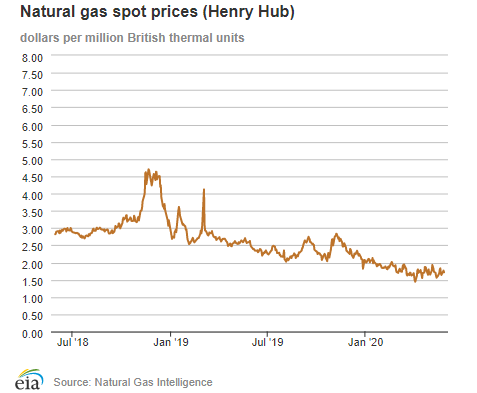
| Spot Prices ($/MMBtu) | Thu, 21-May |
Fri, 22-May |
Mon, 25-May |
Tue, 26-May |
Wed, 27-May |
|---|---|---|---|---|---|
| Henry Hub | 1.69 | 1.64 | Holiday | 1.77 | 1.72 |
| New York | 1.26 | 1.22 | Holiday | 1.47 | 1.52 |
| Chicago | 1.59 | 1.54 | Holiday | 1.71 | 1.73 |
| Cal. Comp. Avg.* | 1.89 | 1.87 | Holiday | 2.18 | 2.18 |
| Futures ($/MMBtu) | |||||
| June Contract | 1.710 | 1.731 | Holiday | 1.793 | 1.722 |
| July Contract | 1.852 | 1.881 | Holiday | 1.945 | 1.886 |
| *Avg. of NGI's reported prices for: Malin, PG&E Citygate, and Southern California Border Avg. | |||||
| Source: NGI's Daily Gas Price Index | |||||
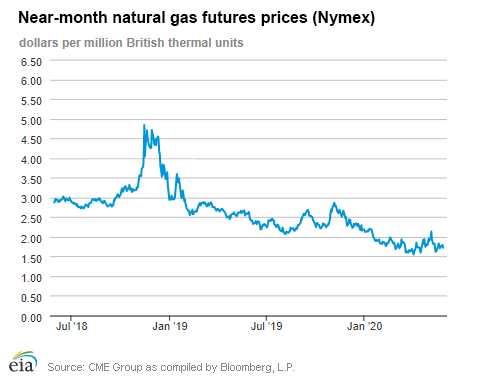
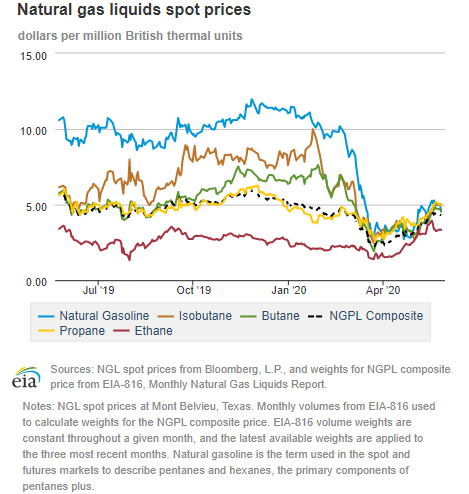
| U.S. natural gas supply - Gas Week: (5/21/20 - 5/27/20) | |||
|---|---|---|---|
Average daily values (Bcf/d): |
|||
this week |
last week |
last year |
|
| Marketed production | 100.3 |
101.1 |
101.7 |
| Dry production | 89.2 |
89.9 |
89.8 |
| Net Canada imports | 4.2 |
4.2 |
4.4 |
| LNG pipeline deliveries | 0.1 |
0.1 |
0.1 |
| Total supply | 93.5 |
94.2 |
94.2 |
|
Source: IHS Markit | |||
| U.S. natural gas consumption - Gas Week: (5/21/20 - 5/27/20) | |||
|---|---|---|---|
Average daily values (Bcf/d): |
|||
this week |
last week |
last year |
|
| U.S. consumption | 60.4 |
60.4 |
60.1 |
| Power | 29.0 |
26.7 |
28.3 |
| Industrial | 20.9 |
21.2 |
21.3 |
| Residential/commercial | 10.6 |
12.5 |
10.6 |
| Mexico exports | 4.7 |
4.8 |
5.1 |
| Pipeline fuel use/losses | 6.0 |
6.0 |
6.1 |
| LNG pipeline receipts | 6.0 |
6.2 |
5.7 |
| Total demand | 77.1 |
77.5 |
77.1 |
|
Source: IHS Markit | |||
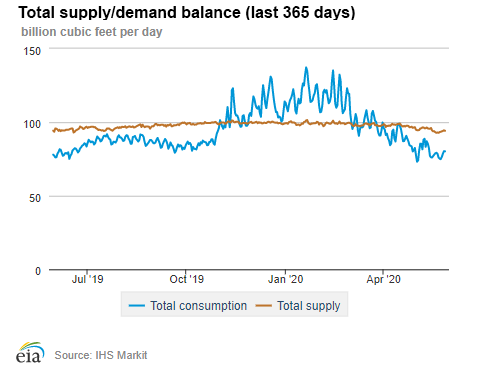
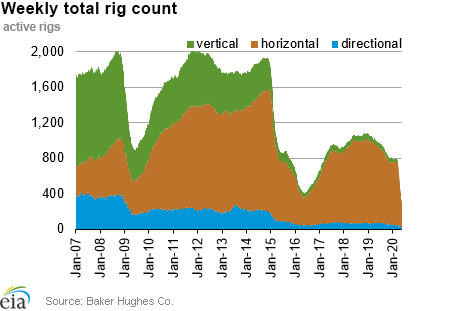
| Rigs | |||
|---|---|---|---|
Tue, May 19, 2020 |
Change from |
||
last week |
last year |
||
| Oil rigs | 237 |
-8.1% |
-70.3% |
| Natural gas rigs | 79 |
0.0% |
-57.5% |
| Note: Excludes any miscellaneous rigs | |||
| Rig numbers by type | |||
|---|---|---|---|
Tue, May 19, 2020 |
Change from |
||
last week |
last year |
||
| Vertical | 8 |
-20.0% |
-84.3% |
| Horizontal | 285 |
-7.2% |
-67.0% |
| Directional | 25 |
13.6% |
-63.8% |
| Source: Baker Hughes Co. | |||
| Working gas in underground storage | ||||
|---|---|---|---|---|
Stocks billion cubic feet (Bcf) |
||||
| Region | 2020-05-22 |
2020-05-15 |
change |
|
| East | 504 |
469 |
35 |
|
| Midwest | 606 |
576 |
30 |
|
| Mountain | 132 |
124 |
8 |
|
| Pacific | 264 |
253 |
11 |
|
| South Central | 1,105 |
1,081 |
24 |
|
| Total | 2,612 |
2,503 |
109 |
|
|
Source: Form EIA-912, Weekly Underground Natural Gas Storage Report | ||||
| Working gas in underground storage | |||||
|---|---|---|---|---|---|
Historical comparisons |
|||||
Year ago (5/22/19) |
5-year average (2015-2019) |
||||
| Region | Stocks (Bcf) |
% change |
Stocks (Bcf) |
% change |
|
| East | 374 |
34.8 |
403 |
25.1 |
|
| Midwest | 389 |
55.8 |
459 |
32.0 |
|
| Mountain | 92 |
43.5 |
134 |
-1.5 |
|
| Pacific | 195 |
35.4 |
254 |
3.9 |
|
| South Central | 784 |
40.9 |
939 |
17.7 |
|
| Total | 1,834 |
42.4 |
2,189 |
19.3 |
|
| Source: Form EIA-912, Weekly Underground Natural Gas Storage Report | |||||
| Temperature – heating & cooling degree days (week ending May 21) | ||||||||
|---|---|---|---|---|---|---|---|---|
HDD deviation from: |
CDD deviation from: |
|||||||
| Region | HDD Current |
normal |
last year |
CDD Current |
normal |
last year |
||
| New England | 54 |
-2 |
14 |
0 |
-1 |
-4 |
||
| Middle Atlantic | 37 |
-6 |
16 |
2 |
-4 |
-8 |
||
| E N Central | 40 |
-9 |
-4 |
2 |
-11 |
-4 |
||
| W N Central | 42 |
-1 |
-17 |
4 |
-12 |
-12 |
||
| South Atlantic | 17 |
1 |
14 |
48 |
6 |
-18 |
||
| E S Central | 10 |
-5 |
9 |
40 |
7 |
-19 |
||
| W S Central | 4 |
1 |
2 |
72 |
12 |
-9 |
||
| Mountain | 35 |
-21 |
-54 |
22 |
0 |
15 |
||
| Pacific | 36 |
0 |
-37 |
0 |
-8 |
0 |
||
| United States | 32 |
-5 |
-8 |
22 |
-1 |
-7 |
||
|
Note: HDD = heating degree day; CDD = cooling degree day Source: National Oceanic and Atmospheric Administration | ||||||||
Average temperature (°F)
7-day mean ending May 21, 2020
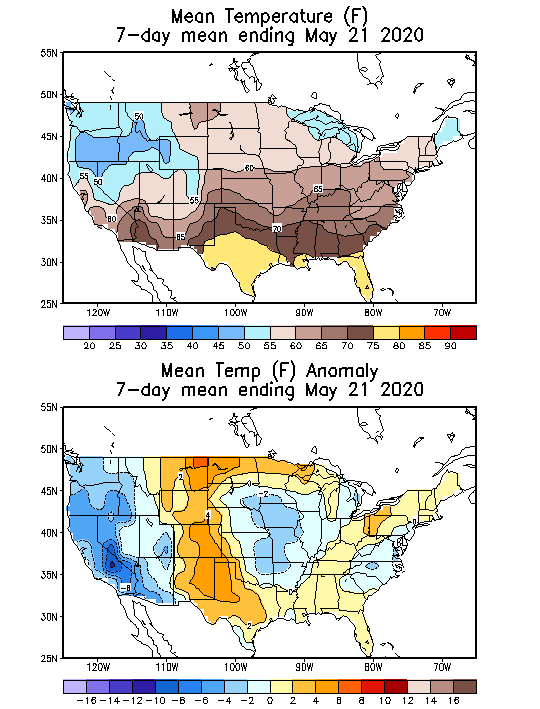
Source: National Oceanic and Atmospheric Administration
Deviation between average and normal (°F)
7-day mean ending May 21, 2020

Source: National Oceanic and Atmospheric Administration

